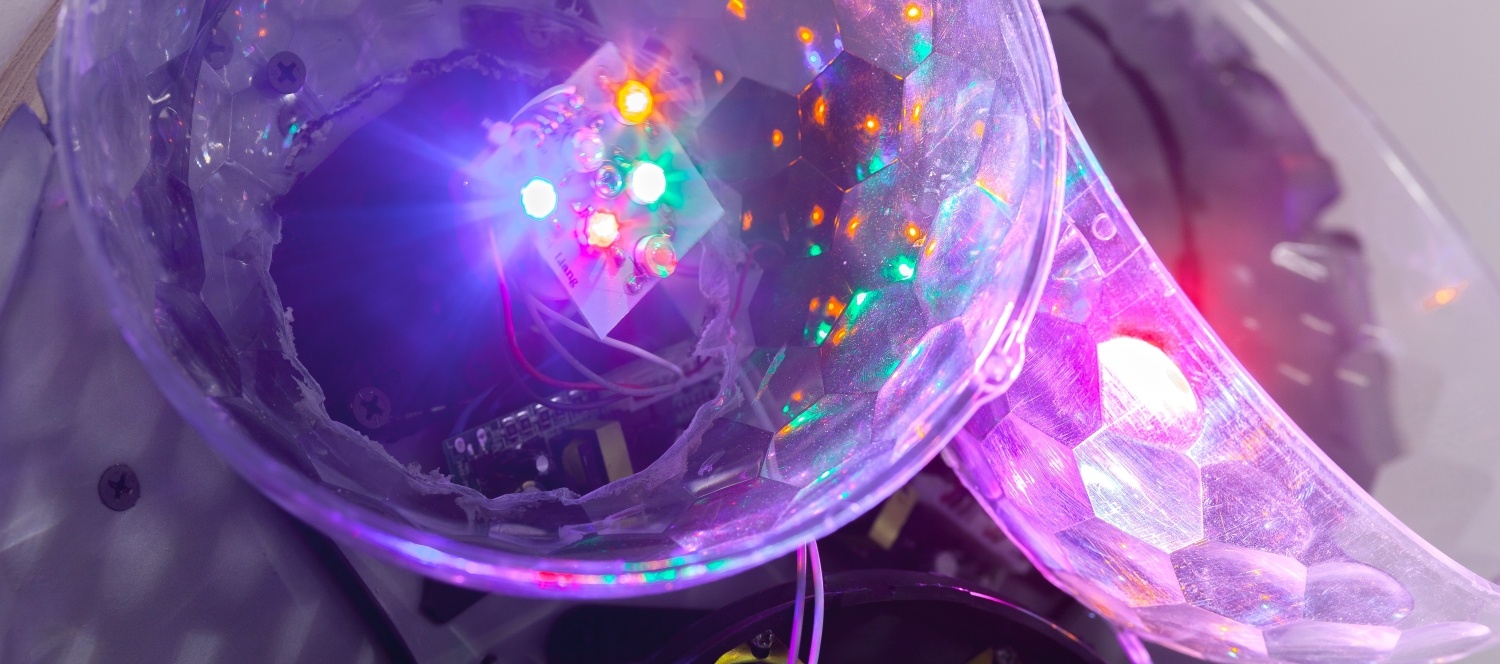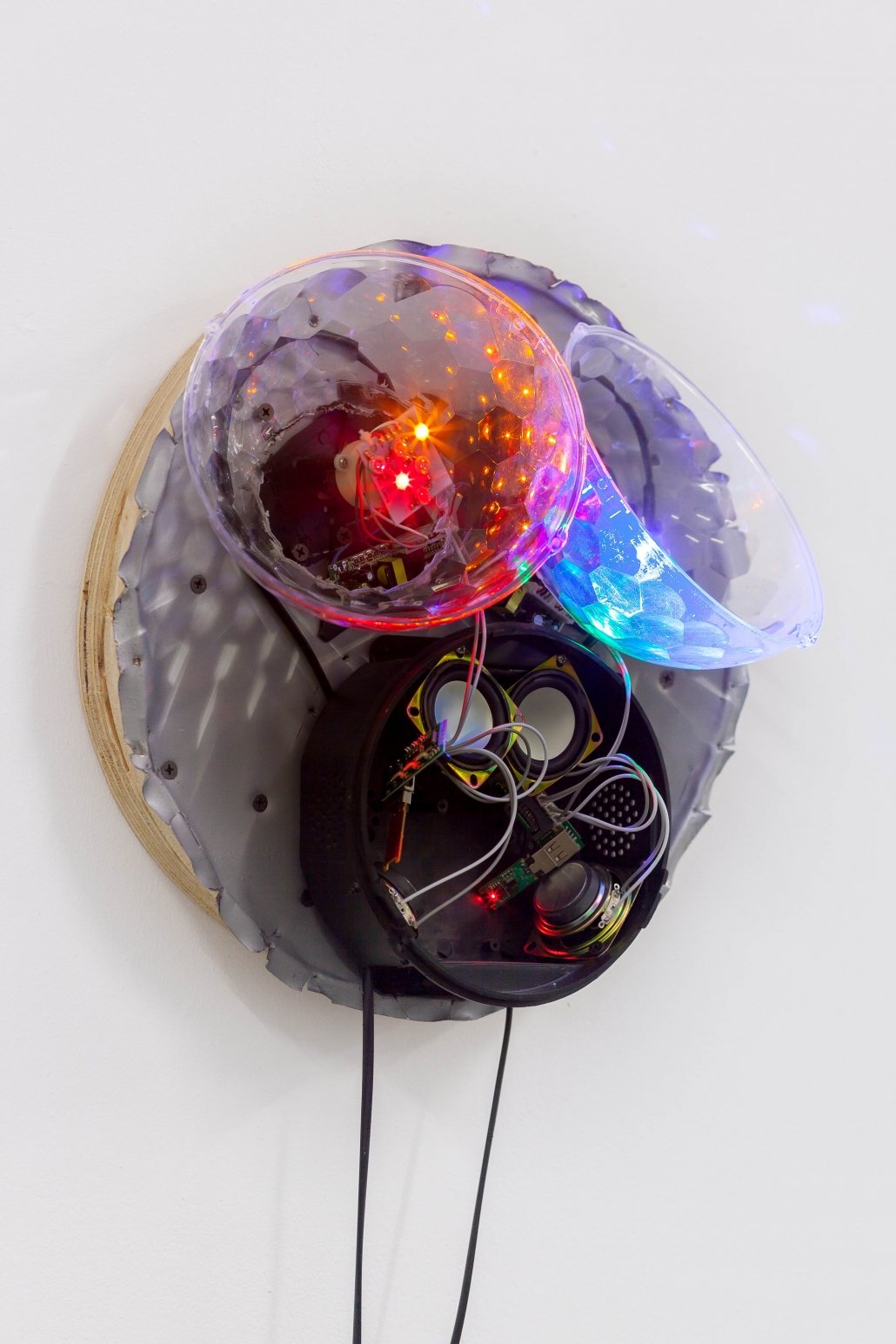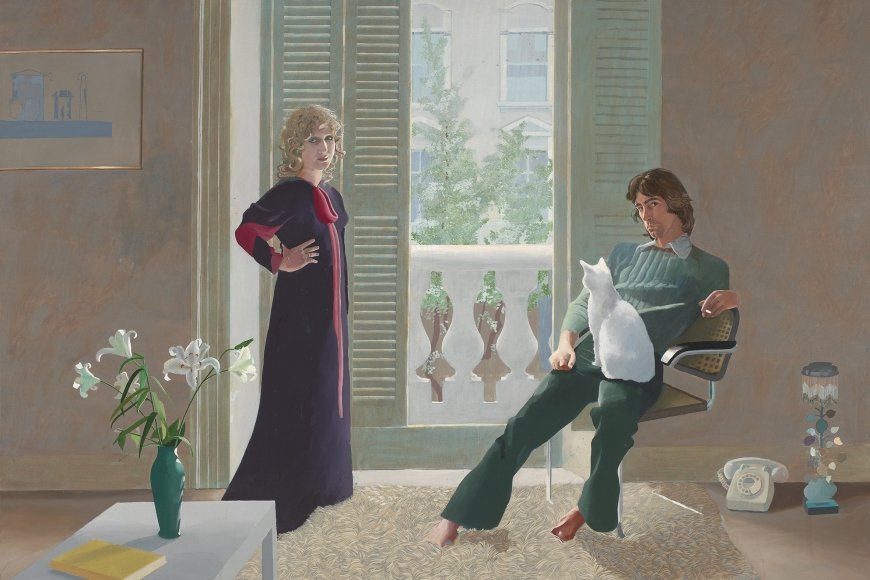Gallery Diary - Vin Vin | MALACLIPTICOPTIROSI

MALACLIPTICOPTIROSI is a solo exhibition by the Italian artist Alberto Tadiello. The exhibition will be on view until 12 March 2021.
One of the most famous and entertaining scenes of the animated film The sword in the stone¹ is undoubtedly the magic duel between Merlin and Madam Mim. The challenge is characterized by numerous transformations into different animals, until the moment Madam Mim, cheating on the rules they had set, turns into a giant purple dragon, captures Merlin – then a small mouse – and thinks she has won that way. But as she opens her hands she sees he has vanished. Will he be dead? No, he has just gotten small, so tiny that he is invisible, microscopic, and precisely this minimally reduced size changes the fate of the battle: “I am a germ…I am called malignalitaloptereosis, and you’ve caught me, Mim!”. In a time of a pandemic, Merlin’s brilliant idea lets us reflect in a different, perhaps less easy-going way, and so it strikes even more that Alberto Tadiello chose this title -Malaclipticoptirosi- (malignalitaloptereosis) for his first personal exhibition after the lock-down, in which he brings together a corpus of works he has created throughout this peculiar 2020.
The artist chose a very precise m.o.: he only worked with what he had at disposal in his atelier², with elements, notes, materials at hand, without being able/wanting to add anything else. Very strict ethics, as he defines it himself, making reference to a mountaineering metaphor: “in the mountains, on a rock wall, when there is little to nothing at hand, you need to look for the easier path, which is obviously not easy at all! But this principle forces you to move according to a logic that lets you save your energies, that is sharp and tends towards the dream of succeeding, with a flawless technique, under a privative sign, while you remain fully aware of your own vulnerability”. The result of this methodology is a seemingly leaner aesthetic, reflecting on the forms and forces underlying artistic practice, in which all the works share a common feature: they revolve around an empty centre.
in the mountains, on a rock wall, when there is little to nothing at hand, you need to look for the easier path, which is obviously not easy at all! (...)
At the centre of the spaces, of the mouths, of the domes, of the parabolas, there seems to be nothing. And yet this emptiness, this absence, has a very strong plastic, almost sculptural value, which in the space of the exhibition is occupied by the physical presence of the cables, which bring the works closer together and almost pull and connect them to each other. On the walls is the triptych Ossicodone (2020), made on panels of pressed chipboard on which concentric faces have been carved, engraved, eroded and insisted upon, in a sort of “synaesthetic circle” - as the artist himself defines it - mixing eyes, mouths, and nostrils³. In this tumultuous vortex, physiognomic features are no longer distinguishable, the faces become masks of astonishment, animal heads, almost swallowing the viewer.

Alberto Tadiello, Exhibition View, Courtesy of the artist & VIN VIN | Photo: Flavio Palasciano
The works are made with coloured pencils, oil pastels, lipsticks, waxes, charcoals, graphite, ash, impregnating agent, in short everything within the artist’s reach in his studio and useful for this powerful, performative and at times violent physical action of repeated superimposition of the same drawing. I see these works as a continuation or natural evolution of the Inoculati cycle, which was first presented at MAMbo in Bologna in 2018⁴, in which the large panels were occupied by a single face, each with the same mechanical repetitiveness, obstinacy of signs, perpetuation of a hollow and profound obsession. In 2018 Alberto Tadiello described them as follows: “they are large, dismayed faces, hollowed-out mouths like funnels full of sound, hissing and roaring. They are feverish, terroristic expressions, in a play of clockwise and anticlockwise, centrifugal and centripetal forces. There is also a great physical investment in the creation of these panels; you can read it with your eyes when you see the pressure of the lines, the erosion of the colours. They are efforts born under the sign of an imperious necessity, all performed in one month after almost three years of research.”
Some of the visual and mnemonic references underlying these works are “Ulisse Aldovrand’s monsters”⁵, Johann Jacob Scheuchzer’s⁶ alpine creatures, the fixed gaze of nocturnal birds of prey, I superimposed wagons of metropolitan faces, studied hallucinations and migraines. They are portraits that mimic the whirling trajectories of atomic particles in nuclear fusion and fission, recall the spinning manoeuvres of drones, and echo the daily profusion of emoticons on mobile phone displays. There is something cannibalistic, erotic, dirty about them. Like gargoyles, they have a great power of spatial prominence, of spirited intrusiveness. I like to think that the centre of the image is actually a great void, a great fear...”. I have always thought of this production as of a development of the studies on sound Alberto Tadiello has been devoting himself for a long time, in particular I am thinking of his experiments on the obsessive superimposition of the same sound file over and over again, where each time the departure is delayed just by few tenths of seconds.
I can’t help thinking of Bruegel’s The Parable of the Blind I saw at the Capodimonte Museum. You know how the character on the right nails you, the one who stubbornly seems to be staring at the viewer? It’s a nightmare that’s hard to forget.
The general sense of the track does not get lost, but a state of trembling, vibration, out of focus creeps in. The effect is that of an accelerated, grainy, vaguely hypnotic ageing process⁷. An intact physiognomy of the piece remains, but a singular rumble is established, like a fugue, a resonance. In the wall sculptures Blind #1 and Blind #2 (2020) these characteristics are evident: they are heads, elementary nervous systems, apparatuses that reverberate sound and light. The sound is a syncopated croaking of several voices, sampled from the calls of tree frogs, which come out of the gaping mouths of completely blind heads. To quote one of the artist’s visual suggestions: “I can’t help thinking of Bruegel’s The Parable of the Blind I saw at the Capodimonte Museum. You know how the character on the right nails you, the one who stubbornly seems to be staring at the viewer? It’s a nightmare that’s hard to forget”.

Alberto Tadiello, Exhibition View, Courtesy of the artist & VIN VIN | Photo: Flavio Palasciano
The first work by Alberto Tadiello I encountered dates back many years, it was USB (2007)⁸, a sound installation which, through electronic equipment, allowed for the transfer into sound of the continuous electrical impulse coming from the sap flowing through the trees. The work made audible the sound of the sap inside the birch trees in the park in front of the museum; I like to think that this tension, this continuous auscultation, was never interrupted, and through works such as Inoculati and Ossicodone it has continued its productive flow and keeps on amazing and frigthening like a small insignificant germ that is able to tame a great purple dragon.

Alberto Tadiello Oxycodone 1, 2020 Mixed media on chipboard, metal profile frame 155 x 190 cm, Courtesy of the artist & VIN VIN | Photo: Flavio Palasciano
The Scream
With an ongoing pandemic and a series of lock-downs imposed on the Italian regions, in Europe, and in the world, Alberto Tadiello decided to work on the core of his personal exhibition in a gallery in Vienna, imposing on himself to use, both materially and conceptually, what he already had in his studio in Belluno. MALACLIPTICOPTIROSI includes sculptural works as well as drawings, works that are both dry and precise, like the artist defines them in an e-mail which he sent to me to tell me about the path he has been following. He also explained to me the title of the exhibition, MALACLIPTICOPTIROSI, a series of consonants preceded by “mala” never promised anything good, and in fact this word is a spell, or actually I should say a curse, pronounced by Merlin at the peak of a magic battle with Madam Mim in the animated film The Sword in the Stone (1963). Merlin shrinks in size to fight his opponent with a magic wand, until he becomes as microscopic as a germ, which attacks the body of Madam Mim, who falls ill in bed. If Madam Mim were in 2021, she would probably react against Merlin with a counter-spell in the form of a vaccine.
The date of the exhibition has been postponed, Alberto has been bringing me up to speed by sending images and videos of the works he has developed; other pieces, which he had mentioned a few weeks ago, are no longer included. The exhibition has been fleshed out, but at the same time it has started to revolve around plastic-sculptural pivots, as well as around dynamic movements, be they hinted at or actual, which capture the viewers’ senses. Blind#1 and Blind#2 are two self-moving wall sculptures that “reverberate lights and sounds” and are articulated as “elementary nervous systems”; if we want to anthropomorphise them, they have heads with eyes, a nose, and a mouth. My visual memory associates Alberto Tadiello’s new sculptures called Blind (that is Blinded, like the LED that animate them) to the eye-eyebrows of the robot that is the protagonist of the animated film Wall-E (2008). Wall-E is the acronym of “Waste Allocation Load Lifter: Earth-Class”; our anti-hero has remained alone in a future world that is made of garbage, and where humans are absent, and he spends his days by saving objects that have no longer a function, but which he finds special and reanimates, amidst piles of electronic waste. The metallic noises that Wall-E emits to communicate can be compared to the sounds which, as Alberto explains, are syncopated sampling of recordings made in proximity of calls for tree frogs – small frogs, for those of you who are not used to the countryside.

Alberto Tadiello, MALACLIPTICOPTIROSI, Exhibition View, Courtesy of the artist & VIN VIN | Photo: Flavio Palasciano
Tadiello talks to me about his reference artistic horizon for this exhibition as a “bare, washed-out, and dazed aesthetic landscape”; I figure the artist as a wayfarer who goes through waste lands, covered in snow, who can adapt and make the most of the scarce equipment he has within reach. Then he writes something a little unsettling: in his intentions, what the works in question have in common is an empty, hollow centre. Instead, I see care and a combative obstinacy in the roundness of the electrical objects as well as in the engraved panels, which seem to me to scream, whirl, and finally burn. They are activated by absence, instead of being switched off or defeated by it. Ossicodone [oxycodone] is the title recalling an opioid, a pain-killer that can become addictive, of a series of three panels of pressed chipboard where the artist applies a rotating, obsessive movement, a movement of digging, engraving. The mechanical gesture frees or holds the faces, as the genesis of an animation that could become appeased or, on the opposite, lose control and get out of axis. The surface screams, darkened by the circles that swarm so much as to turn into whirlpools, eddies, black holes.
1 La spada nella roccia (The Sword in the Stone) è un film di animazione del 1963 diretto da Wolfgang Reitherman. prodotto dalla Walt Disney e distribuito dalla Buena Vista Distribution 2 Dal 2015 l’artista ha impiantato il suo studio in provincia di Belluno, in un ex-panificio ai piedi delle Dolomiti 3 Due opere di questo trittico sono state presentate in precedenza al Museo Burel di Belluno nella mostra Diversi, a cura di Daniela Zangrando, 12 giugno - 1 agosto 2020 4 Il ciclo faceva parte della mostra That’s IT! Sull’ultima generazione di artisti in Italia e a un metro e ottanta dal confine, a cura di Lorenzo Balbi, MAMbo – Museo d’Arte Moderna di Bologna, 22 giugno 2018 – 6gen- naio 2019. Una delle tavole del ciclo Inoculati, entrata nella collezione permanente del MAMbo grazie al sostegno di Philip Morris Italia alla biennale doutdo è attualmente esposta nella sezione Officinad’Arte Italiana 5 Il bolognese Ulisse Aldrovandi (1522-1605), naturalista e botanico, è autore di uno dei testi illustrati più noti, in materia di mostri: la Monstrorum Historia, pubblicata postuma nel 1642 6 Johann Jakob Scheuchzer (Zurigo, 1672 – 1733) è stato un naturalista e medico svizzero, noto per la sua interpretazione dei fossili, che riteneva vestigia del Diluvio universale 7 In particolare, in riferimento a questa ricerca, si guardi la serie EPROM (2008), presentata nel 2010 alla Fondazione Sandretto Re Rebaudengo nel contesto della T2 – Torino Triennale. 50 lune di Saturno, a cura di Daniel Birnbaum, 17 ottobre – 5 novembre 2010 8 L’opera, attualmente nella Collezione AGI di Verona era stata prodotta e presentata per la mostra Silenzio. Una mostra da ascoltare, a cura di Francesco Bonami, Fondazione Sandretto Re Rebaudengo, Torino, 1 giugno – 23 settembre 2007



